Are you curious about which digital trends will impact e-commerce SEO in 2024? We have analyzed the e-commerce line of business using Serpstat Market research data and experts’ comments. This in-depth investigation will explore the trending top 5, focusing on AI, sustainability, and exciting SEO tendencies.
Analysis of SEO Trends Shaping the E-commerce Industry
Typically, e-commerce experts track Revenue, Traffic, and Visibility as their most critical success metrics. In our research, we will start gathering data considering these valuable indicators. The updated Serpstat Market research helps to find SEO Traffic, Visibility, Organic keywords, Referring domains, Backlinks, and SDR (Serpstat Domain Rank). It will be the basement of our research, 100 domains, and their metrics (10 domains in 10 e-commerce subcategories).
Serpstat market research tool
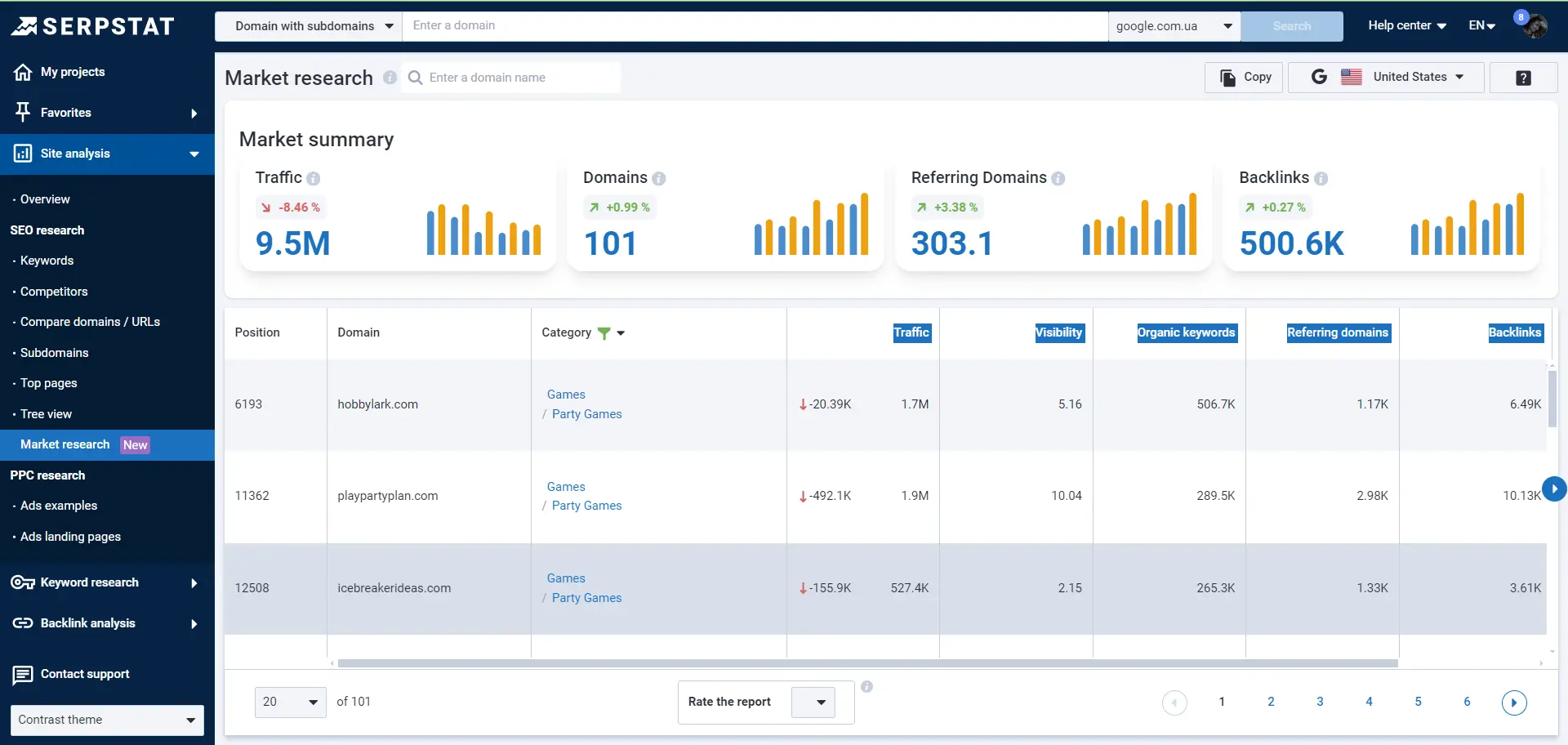
We analyzed the Market summary panel for each e-commerce category using the US search database. Shopping portals like eBay, Amazon, and Aliexpress, as well as mass merchants such as Target and Walmart, dominate SEO traffic.
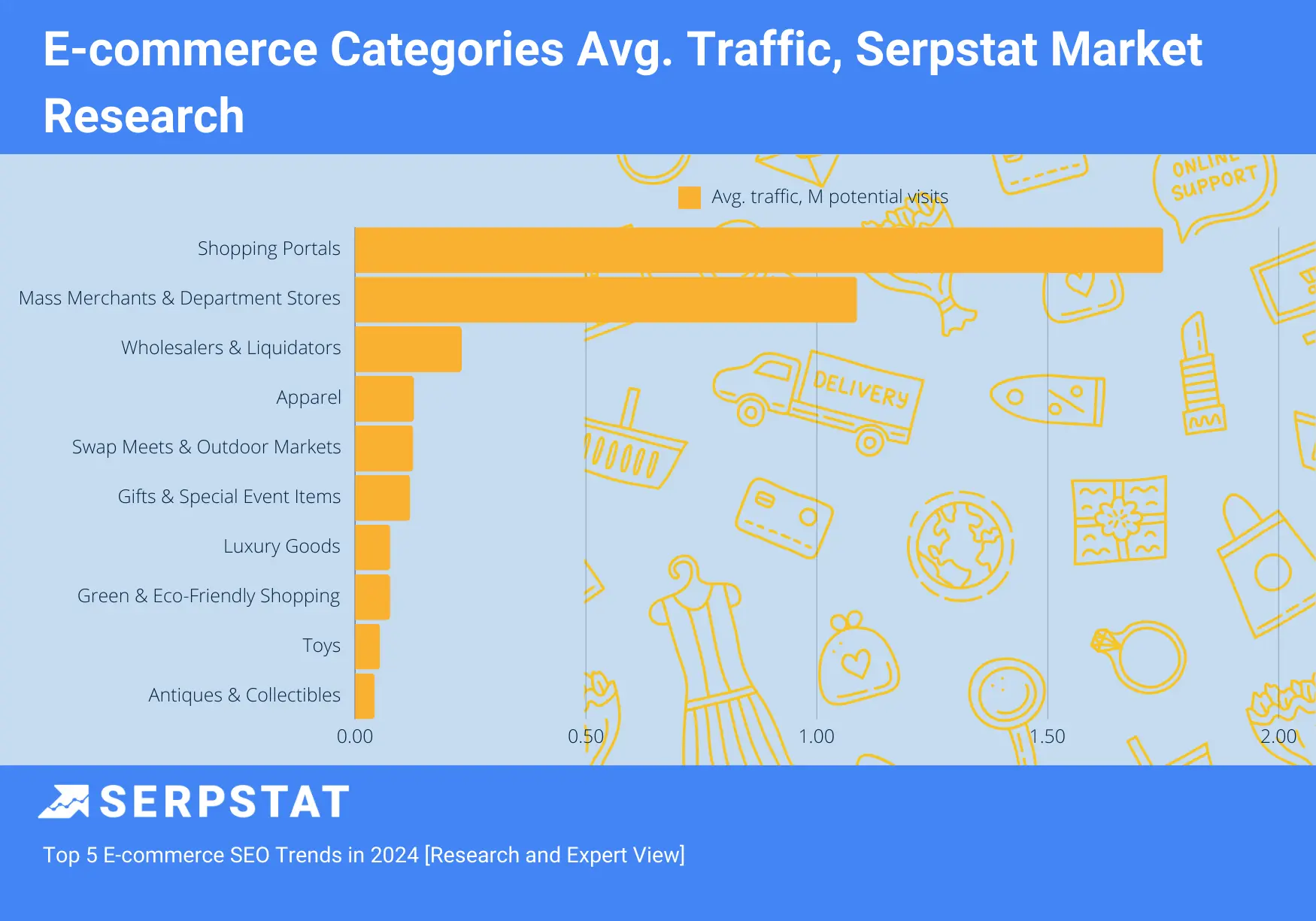
This pattern underscores the competitive nature of SEO in e-commerce, highlighting the importance of innovative strategies to stand out in a crowded marketplace.
Transitioning from this research-based overview, we conducted interviews with industry representatives. Let’s uncover the industry’s significant challenges:

John Morabito
I think data availability will become increasingly difficult. As searches move to other platforms (AI, TikTok, etc.), planning and measurement will eventually become more art than science.

The concern over data availability stems from the diversification of search platforms beyond traditional search engines. As users increasingly turn to AI-driven tools and social media platforms for information and shopping, gathering and analyzing data for SEO becomes more complex.

Liam Carnahan
The biggest SEO challenge I currently face is dealing with the fallout of the HCU update.

The recent updates, in turn, challenge e-commerce sites to alter their content strategies to ensure they align with the new criteria for ‘helpfulness’ and user focus.
Traffic Sources for E-commerce and Shopping Sites
Next, let’s move to the traffic sources to realize how much influence organic search has on the leading domains. Thanks to the Domain batch analysis, we chose the top 10 most visible websites.
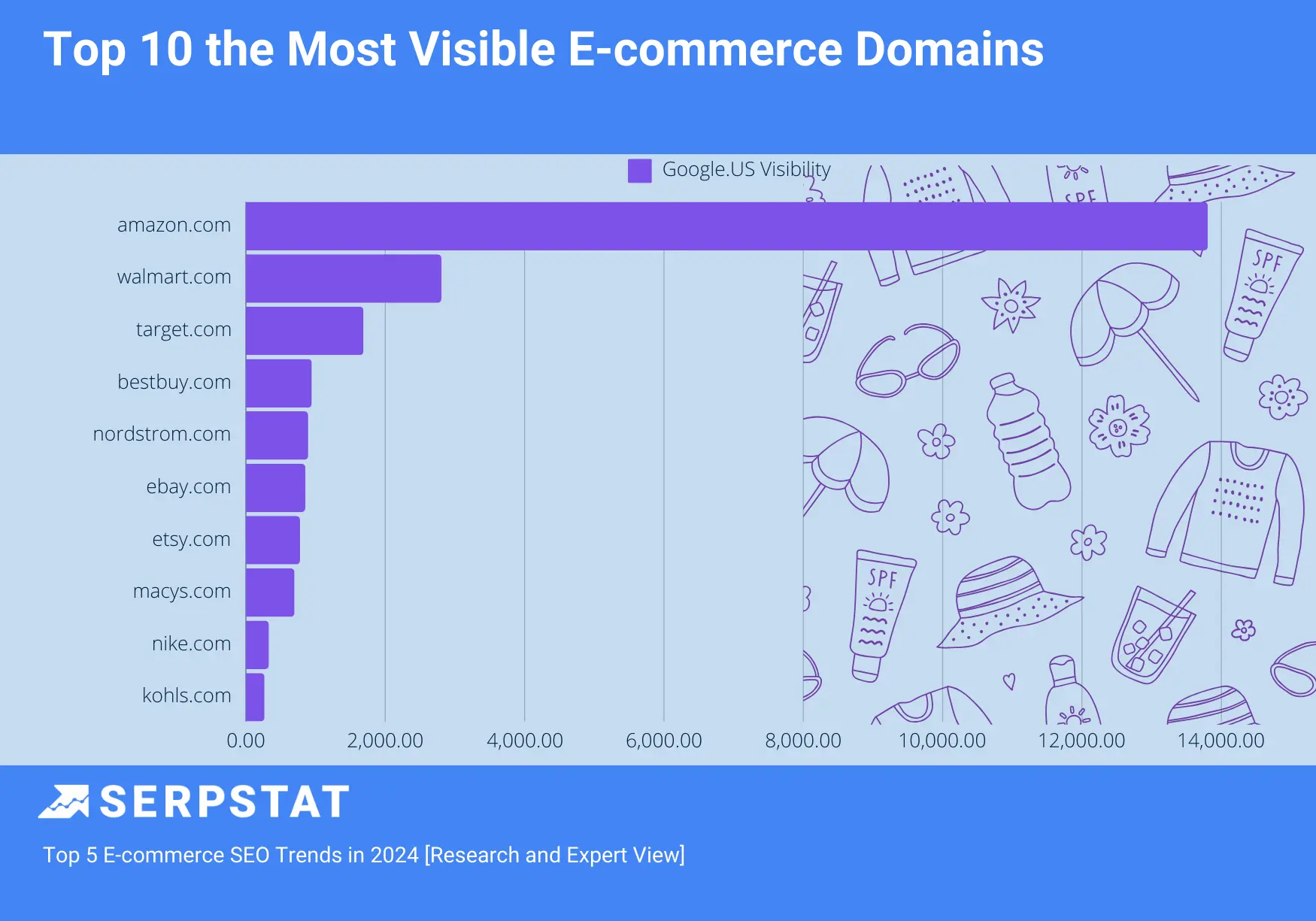
*The Visibility Index also might be affected by Google updates on rankings. We took the data after the Google Core and Spam Update in March.
Then, we can check the traffic sources using SimilarWeb:
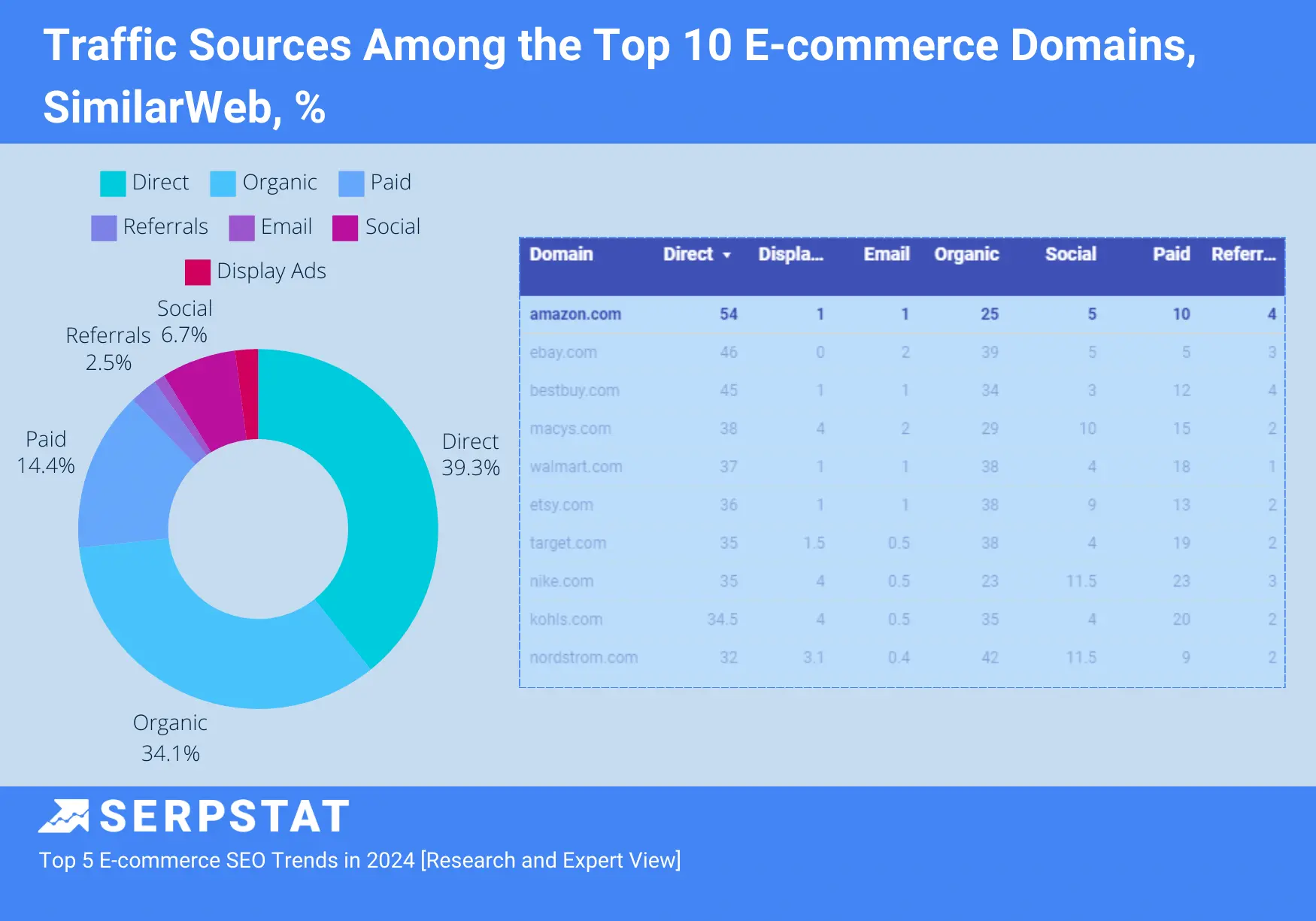
The average ad traffic is around 15%, and organic traffic is 34%. This is a significant ad-to-organic traffic ratio compared to other business lines we have researched. This strong reliance on these sources indicates that SEO and advertising strategies are essential for driving customers to e-commerce platforms.
Advertisement in E-commerce
It is well-known that e-commerce businesses extensively use paid advertising, including Google’s Performance Max campaigns. Performance Max allows e-commerce to automate their ad campaigns across all of Google’s channels, including Search, YouTube, Display, Discover, Gmail, and Maps.
The results of our research reveal that the highest quantity of ads in search has:
- Shopping Portals
- Mass Merchants & Department Stores
- Toys
- Apparel
- Gifts & Special Event Items
These e-commerce businesses invest heavily in online advertising to capture consumer attention.
The most expensive CPC keywords suggest that e-commerce also actively uses local SEO. Among these keywords are ‘near me store open,’ ‘clothing stores,’ ‘store groceries,’ and ‘nearest store to me.’
This dual focus on extensive paid advertising and local SEO underscores e-commerce businesses’ multifaceted approach to enhance visibility and attract a diverse customer base.
Keyword Research
When looking at the indicators by e-commerce domains, the first thing that comes to mind is that among the dropped and lost keywords (search terms a domain doesn’t rank for in the top 100 anymore), many domains are in the categories Gifts & Special Event Items (21%), Apparel (19%), Toys (8%), and Antiques & Collectibles (8%).
The observation suggests a shift in consumer interest or search behavior. This could be due to various factors, such as changes in market trends, consumer preferences, or the emergence of new competitors.
In the context of e-commerce in 2024, these changes might indicate:
- Seasonal variations
- Consumer trends. Shoppers might be moving towards new product categories or favoring different shopping experiences, such as personalized products or sustainable goods.
- Technological advancements, such as the rise of AR and VR and AI-driven personalization, are reshaping the e-commerce landscape.
- Geopolitics. For many retailers, the russian-Ukraine war also had serious implications for their supply chains. As utility prices have risen, inflation has risen, and the cost of living has increased, disposable income has declined.
“Wholesalers & Liquidators” and “Swap Meets & Outdoor Markets” are experiencing more stable demand and pricing than others. This stability could be due to a consistent need for wholesale goods and the nature of liquidation and swap markets, which can thrive even during economic downturns as consumers look for discounted and second-hand items.
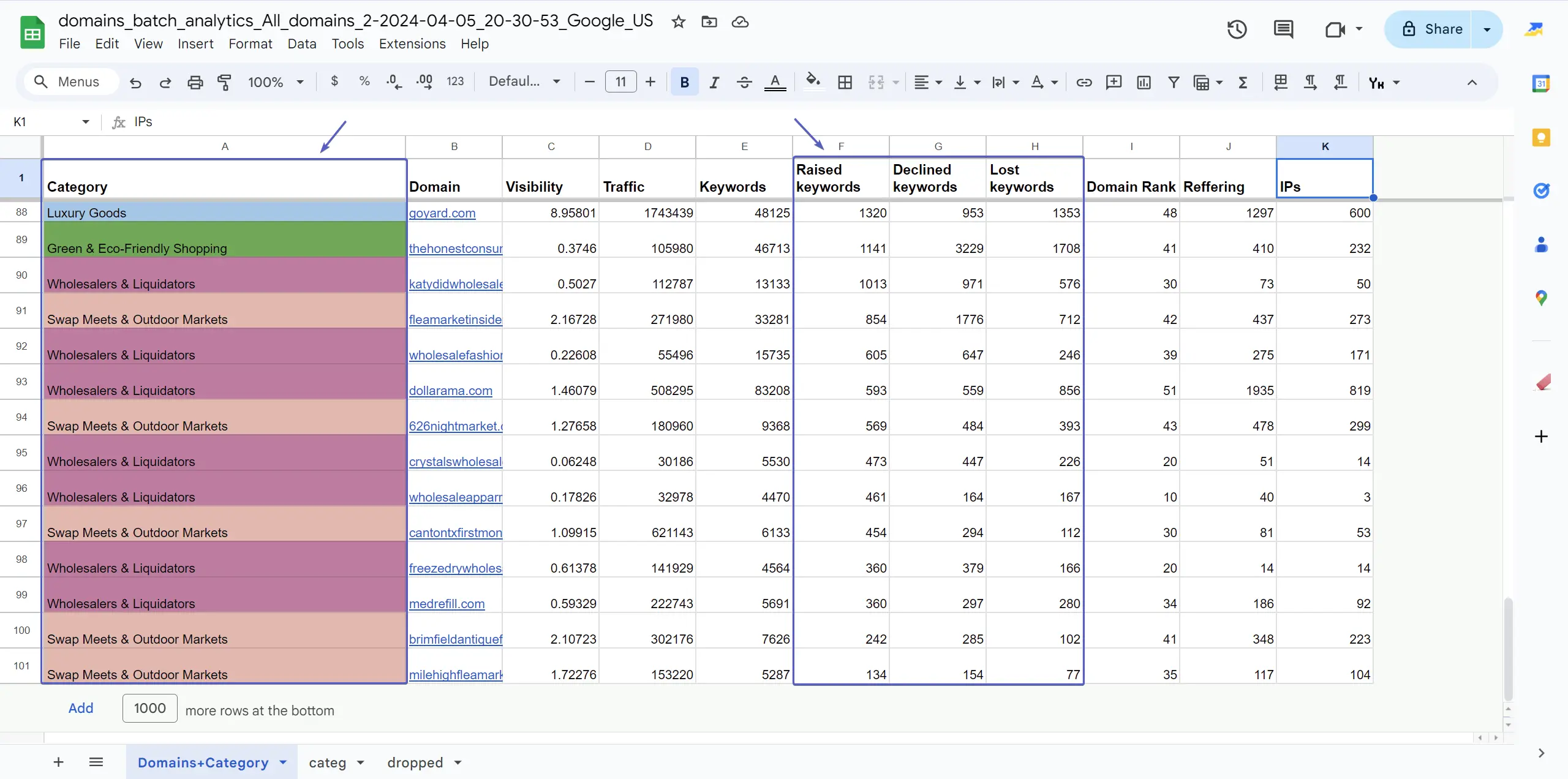
It suggests that despite changes in the e-commerce landscape, these areas remain relatively unaffected by the shifts impacting other categories like Gifts, Apparel, Toys, Antiques, etc.
The leading keywords by the search volume are:
- Amazon — 124 M
- Walmart — 55.6 M
- Target — 30.4 M
- Amazon Prıme — 24.9 M
- Ebay — 24.9 M
- walmàrt near me — 11.1 M
- Nike’s — 6.1 M
Here are the most competitive keywords in our analysis. It means that these keywords can be found the most frequently among the competitive commercial domains:
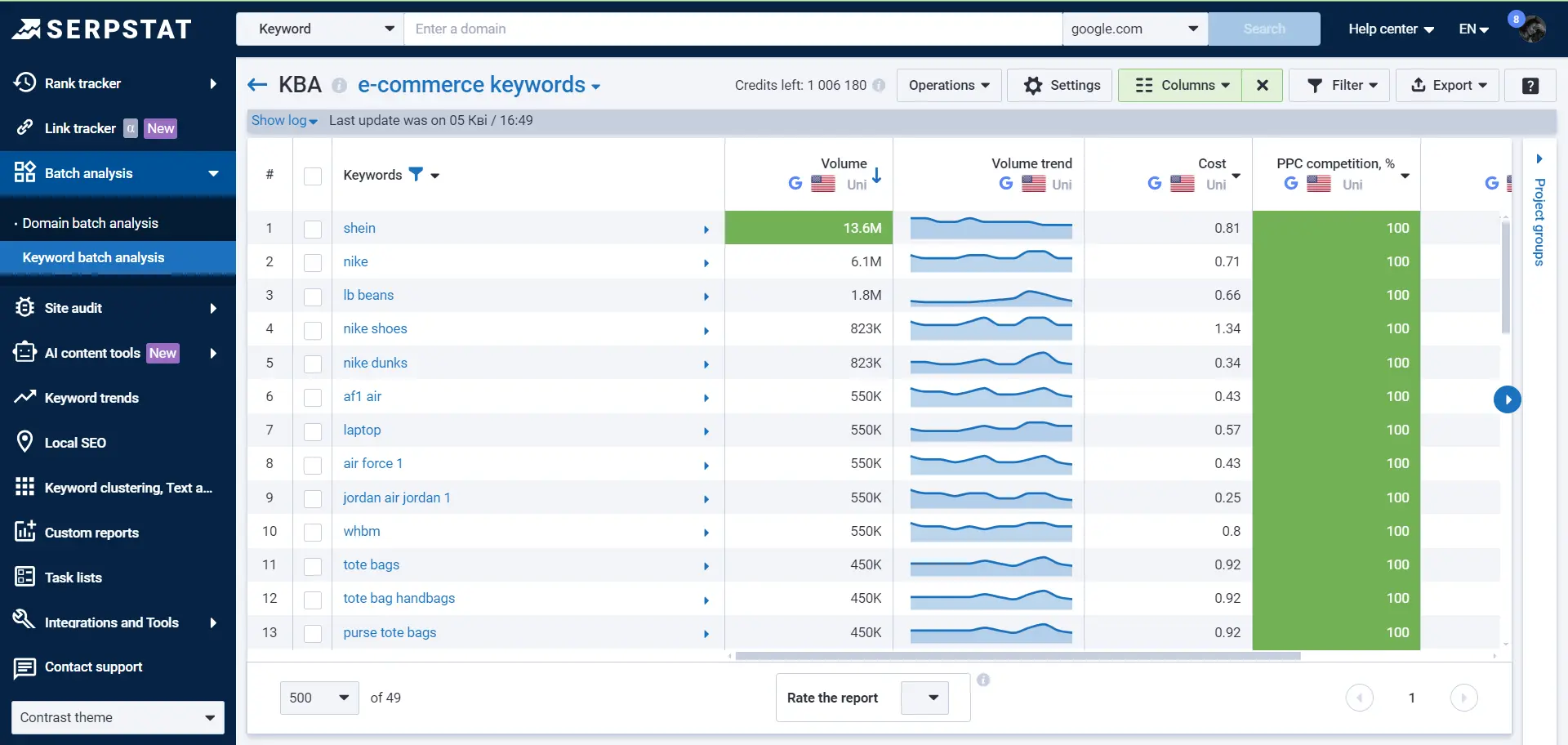
Of course, it is worth mentioning seasonality in the context of traffic fluctuation. SEO for e-commerce must align with seasonal trends and events influencing consumer behavior (holidays, weather changes, or cultural events). Earlier, we wrote about predicting product demand with a Search volume crawling service.
One key point e-commerce companies use is creating and scheduling content that resonates with the season, such as gift guides for holidays or summer essentials.
In the context of keyword research, AI technologies, including those powering SGE, transform how search engines understand and respond to user queries. SGE uses AI to generate more contextual and direct answers, aiming to satisfy user intent without the need to click through to a website. This approach to search queries prioritizes the most relevant information, often pulling from and summarizing content found across the web, including product details.
In the context of the SGE, what are the key strategies e-commerce platforms should adopt to optimize their visibility?


John Morabito
One shift in strategy is SEOs’ focus on PDPs (product detail pages), whereas historically, we have focused much more on category-level pages. With Google seeking to be the category page for most e-commerce terms, product detail pages have become the entry point for many queries.
From a tactical perspective, merchant listings and schema play important roles in ensuring you are even in the running to show up. The SGE product grid is driven by the Shopping Graph, which also drives the current Google Shopping experience.

This evolution means that e-commerce platforms need to rethink and adapt their SEO strategies and Zero-click scenarios.
Backlinks in E-commerce SEO
Let’s move to another vital component of e-commerce SEO: Backlinks. Links from authoritative sources can enhance the perceived trustworthiness of your e-commerce site. During our analysis, we found that not only giant marketplaces use link-building but also well-known and trusted brands:
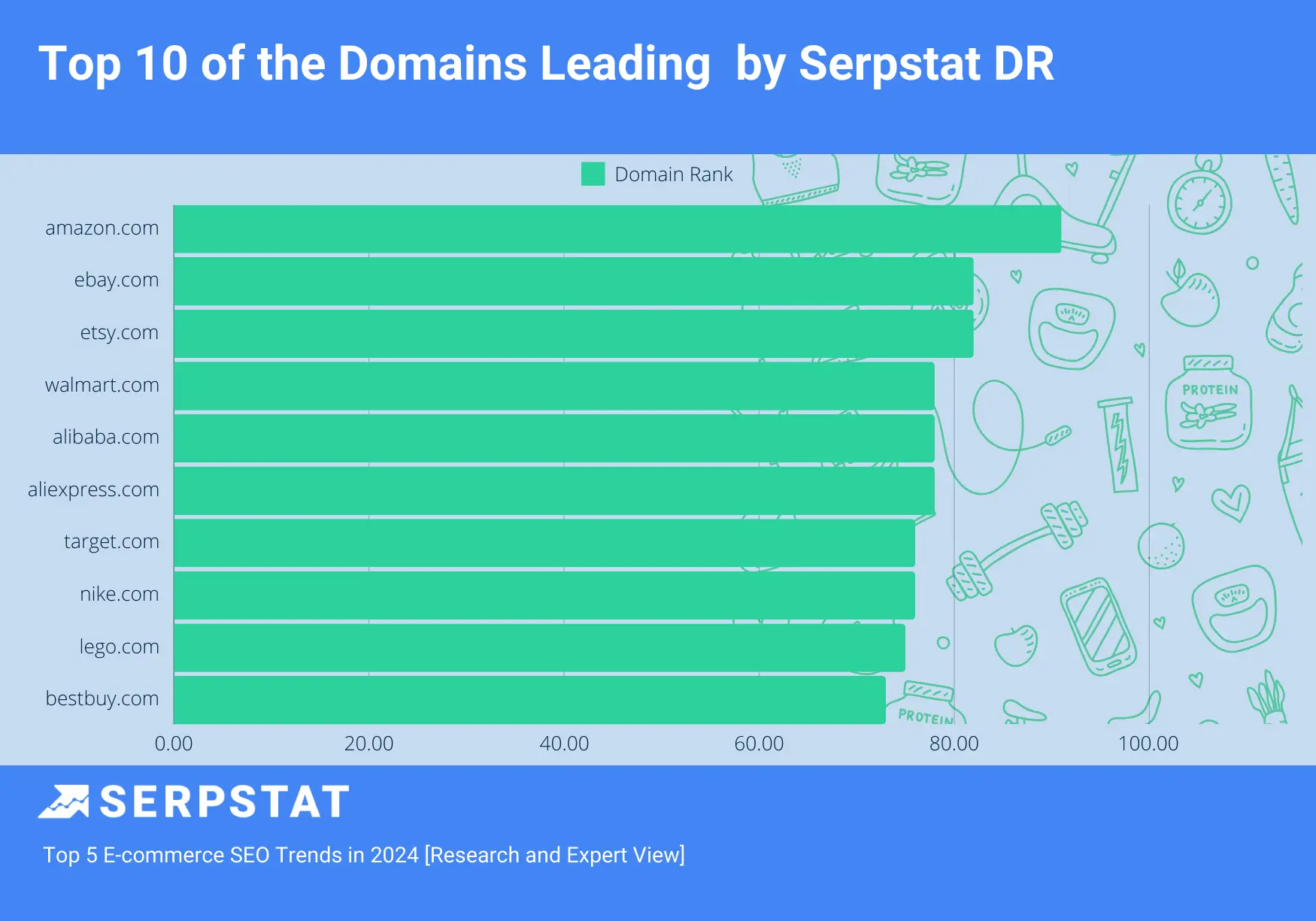
The exact domains are led by unique IP subnets as backlink donors. It means that the backlinks to these e-commerce domains come from diverse sources across different networks. A diverse backlink profile suggests that various sources recognize and trust a website.
Acquiring backlinks can be challenging for e-commerce sites, but strategies like creating valuable content, engaging with influencers, and using social media can help attract natural mentions. It’s also important to focus on the quality of backlinks rather than quantity, as search engines prioritize links from relevant and authoritative sources.
Finally, let’s summarize the research with the main tendencies.
Top 5 Key Trends of E-commerce Business
It is important to note that AI is only one of the e-commerce trends of 2024. Many other techniques and practices are gaining popularity among marketers for boosting search visibility and attracting high-intent organic traffic. Let’s review them!
#1: Sustainability and Responsibility
Climate, war, and crises are setting in, and we are beginning to demand greater responsibility. The focus on sustainability and environmental friendliness has gained momentum. In 2024, this trend is likely to intensify in the e-commerce sector. Customers expect platforms to offer eco-friendly options, reduce waste, and implement green practices.
Businesses’ sustainability and environmental impact have become increasingly significant in buyer decisions. A great example is the negative attitude to ultrafast fashion brands like Chinese SHEIN. Retailers now need to deploy sustainable processes throughout their supply chain and manufacturing stages and be able to demonstrate this to consumers.
According to McKinsey’s 2020 survey on US consumer sentiment, more than 60 percent of respondents would pay more for a product that was packaged sustainably:
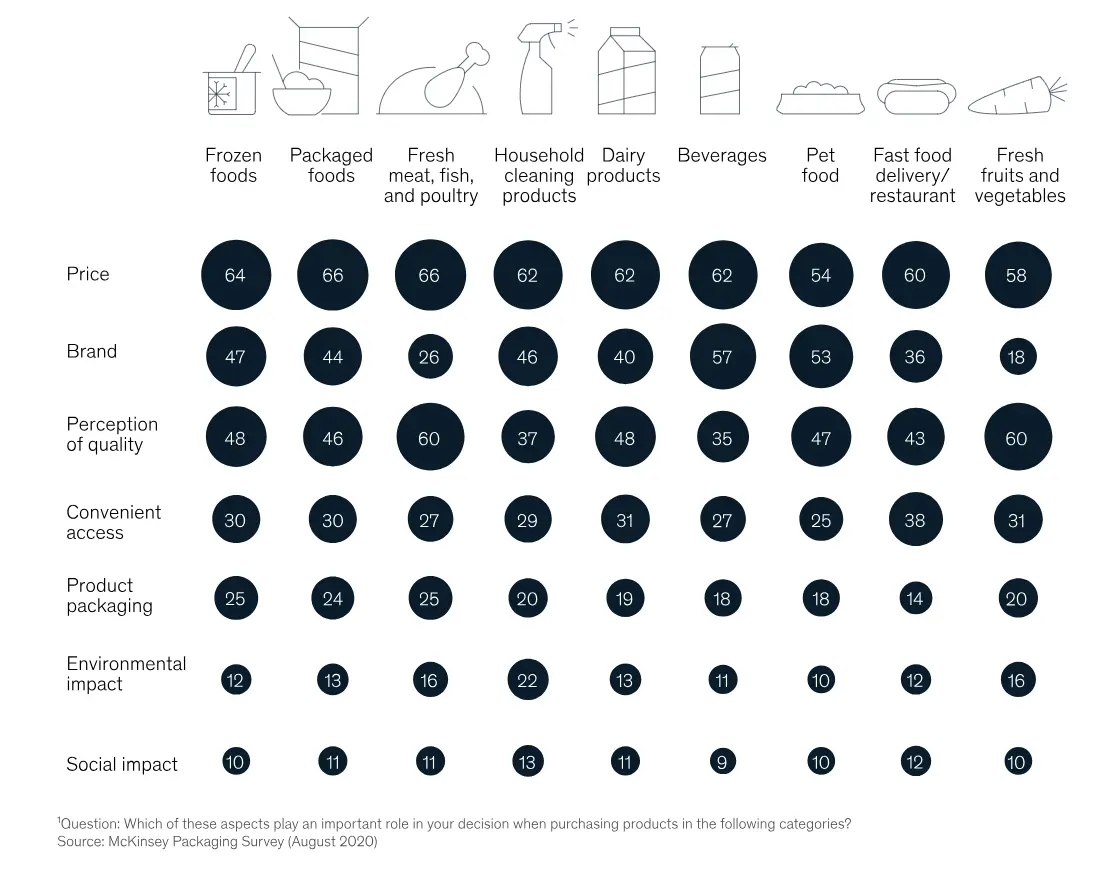
E-commerce digital businesses are increasingly aware of their carbon footprint and are looking for ways to reduce it. They can minimize their environmental impact by choosing cloud services like BigQuery that prioritize low CO2 emissions. Serpstat mainly uses such servers on the Google Cloud Platform.
Source: Google Cloud
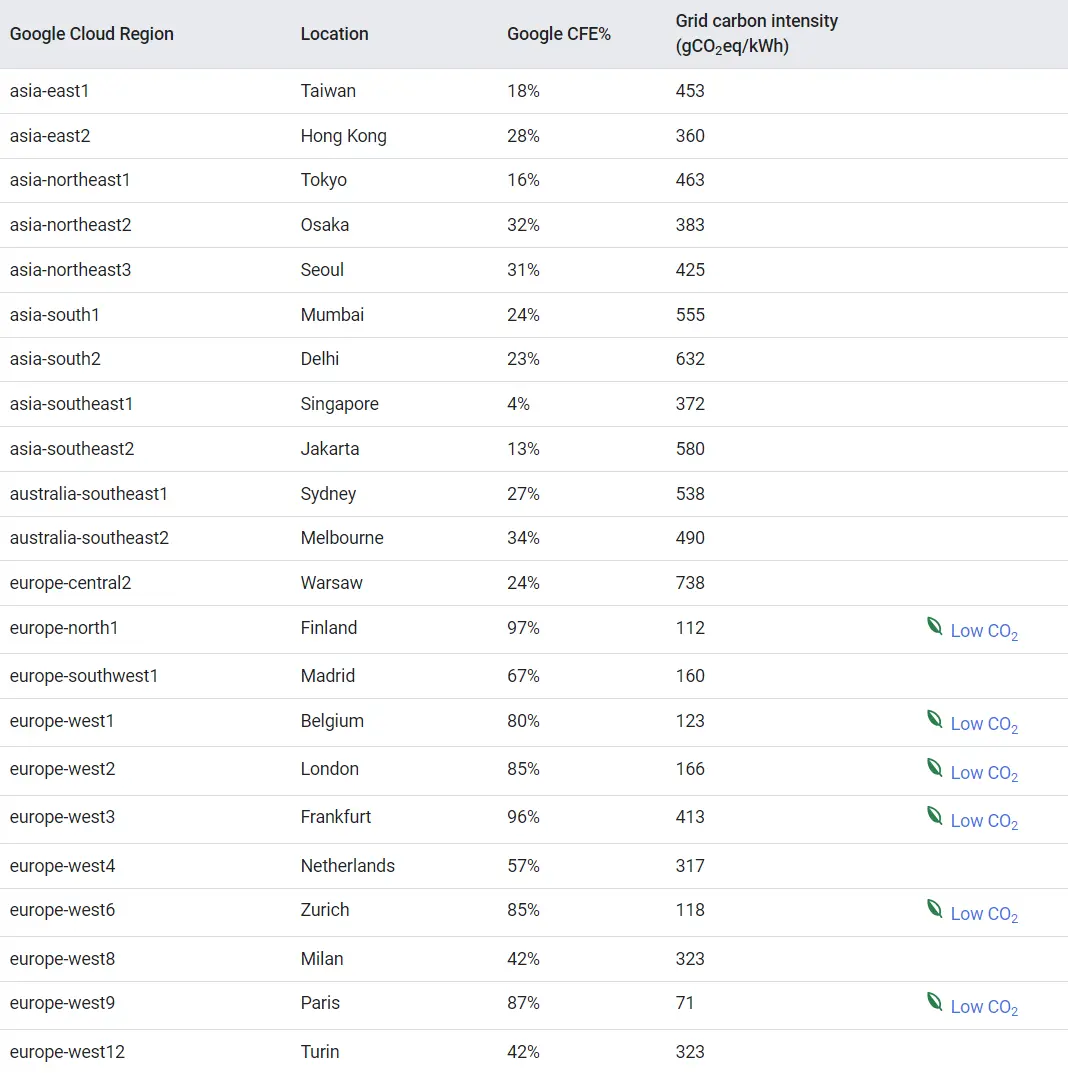
Trends like this are here to stay.
However, sustainability encompasses more than environmental issues; it includes ethical SEO practices. Businesses thrive through ethical link-building practices, meticulous content optimization, and strategies that positively impact the online ecosystem and preserve its integrity. It’s one of the recent trends in SEO.
#2: Visual Search
One of the rising trends in e-commerce will be visual search. This technology allows users to search the web using images instead of text. It’s helpful when you want to find more information about something you’ve seen but need the words to describe it. You can upload an image or take a photo, and the search engine analyzes it using AI and visual recognition technology. Here’s where you can use it to find the best deal:
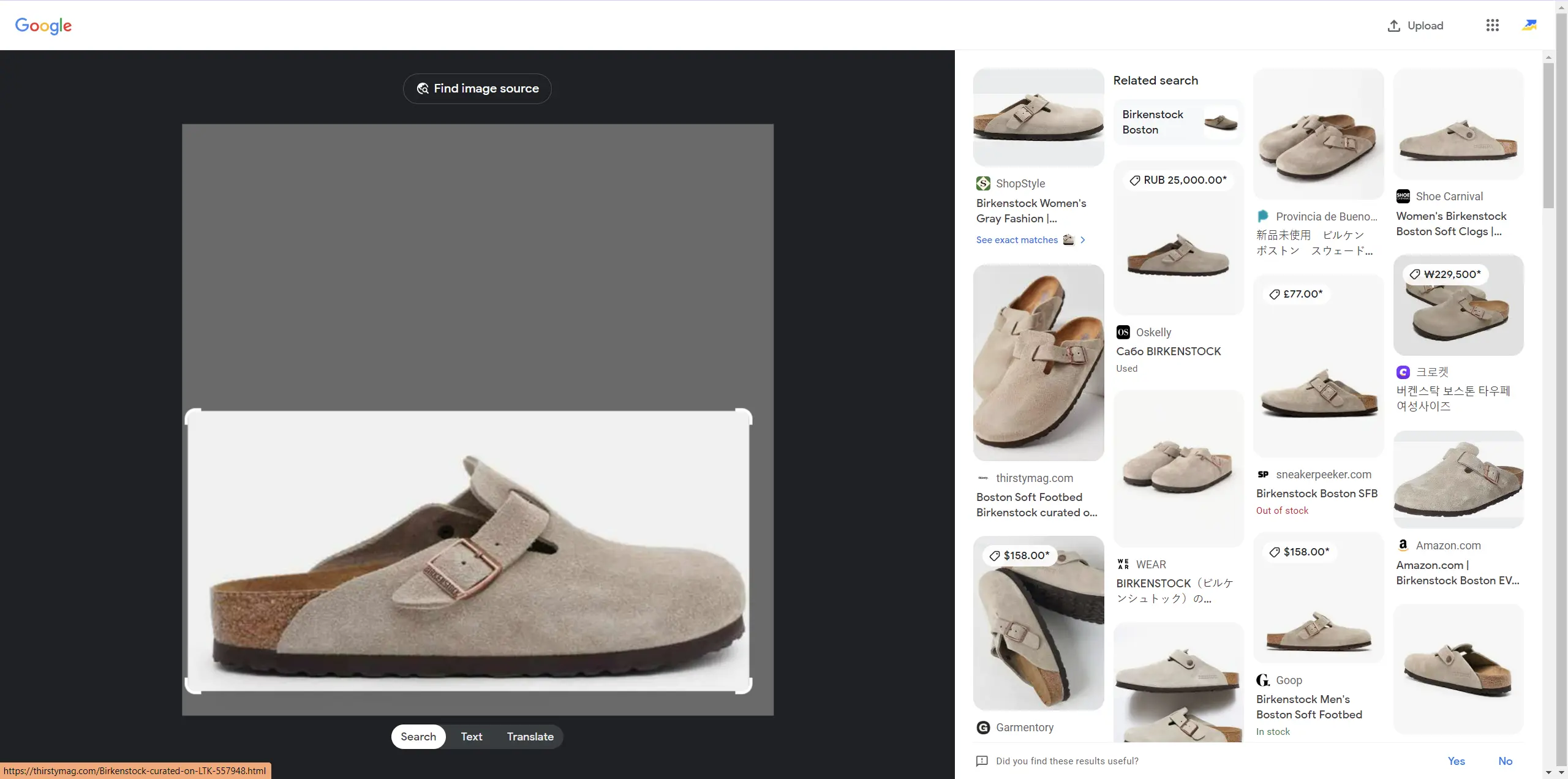
Big brands like Amazon, Target, and eBay have leveraged visual search for years. Now, more e-commerce stores are adding this feature to make product searches easier for their customers than ever before. It offers your customers an innovative way to find what they’re searching for and sends positive signals to search algorithms by increasing engagement and time spent on your site.
#3:Trending E-commerce AI
Let’s talk about some cases of unusual usage of AI. It can be used to improve e-commerce operations in several ways:
- ****** analyze customer data to suggest products tailored to individual preferences.
- AI predictive analytics help forecast demand, optimize stock levels, and reduce waste.
- AI systems can identify patterns indicative of fraudulent activity, protecting the business and its customers.
- AI can adjust prices in real-time based on market demand, competition, and customer behavior.
- Generative AI can be used to create new product designs or content.
- Offering virtual try-ons or visualizing products in a customer’s home can boost sales and engagement. Btw, it will also improve SERP ranking.
- By analyzing customer engagement and purchase history, AI can predict which customers are at risk of leaving and help create strategies to retain them.
Besides, as mentioned before, Performance Max is designed to assess audience signals and preferences using machine learning. Such automated platforms are becoming increasingly common as they offer the ability to manage campaigns more efficiently and potentially improve return on investment.
The continued development of AI applications in the e-commerce future is anticipated to enhance the customer experience and further propel business growth.
With the increasing importance of AI and machine learning, how should brands adapt their SEO strategy for e-commerce websites?


John Morabito
To start, leveraging AI as the powerful productivity and creativity enhancer that it is. Secondly, prepare and adapt to the new landscapes where searchers will be.

What’s the best SEO strategy while waiting for the full release of SGE?


Liam Carnahan
It’s so hard to say because we don’t know what SGE will look like if and when it rolls out fully. Right now, the best thing to do is stay the course — keep writing high-quality, optimized content for your audience. I am watching SGE very closely, but I find it pays to be patient instead of making rash decisions in SEO.

#4: Quick Commerce
AI enhances online commerce trends through realistic simulations, personalizing virtual try-ons by analyzing body data and preferences, thereby improving customer satisfaction. It offers efficient, real-time try-ons without physical fitting rooms and reduces returns by accurately depicting how clothes will fit and look on various body types.
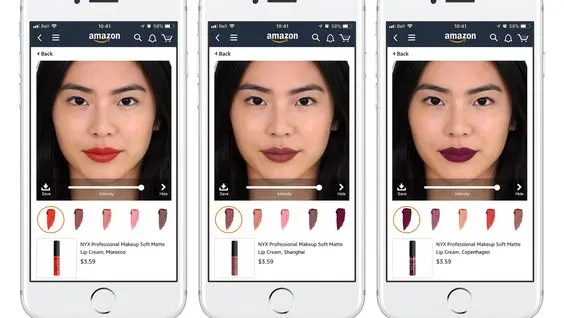
Companies like Ikea have been using AR technology for years:

#5: Digitalization of Luxury Brands
Despite efforts like exclusive collections, some stores still struggle financially in 2024. To do better, experts suggest focusing on realistic sales predictions and being flexible in selling.
Luxury e-commerce platforms must differentiate themselves from direct brand sales by making shopping more accessible and attractive for customers. To attract visitors, these online stores have started offering discounts and digital innovations. The digitalization of luxury brands represents a significant shift in how they interact with consumers and manage their operations. Here are some key points about this transformation:
- Luxury brands are expanding their online footprint, offering e-commerce options and digital experiences to reach a broader audience. For example, the Japanese skincare group Shiseido created a campaign using AI to gauge customer emotions, NFT for promos, etc.
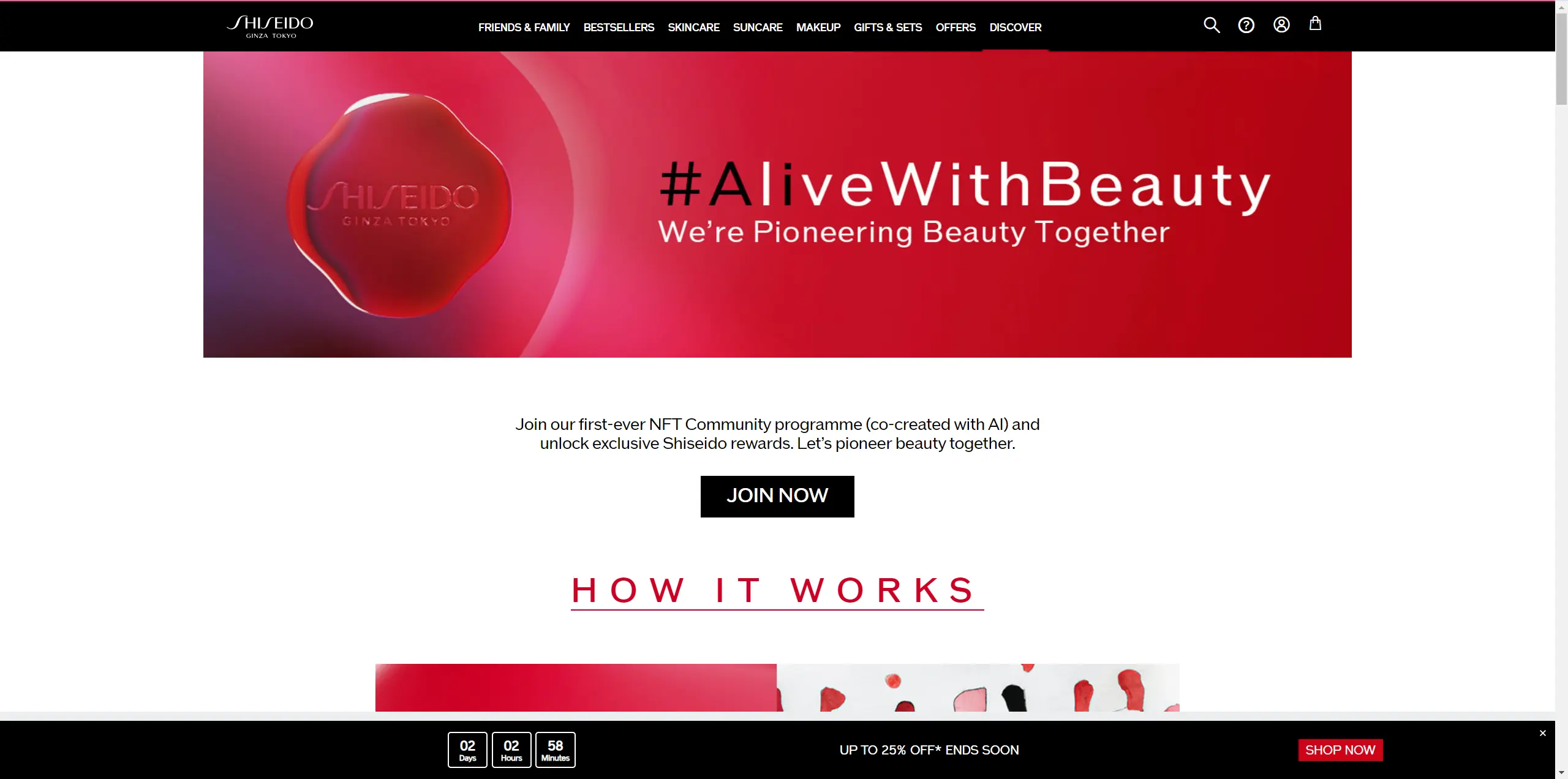
- Luxury brands can offer personalized shopping experiences through data analytics and AI, enhancing customer loyalty.
- Brands leverage social media platforms for marketing and engaging with customers, often using influencers to reach target demographics.
- Some luxury brands adopt blockchain for authenticity verification and accept cryptocurrencies as payment.
Digitalization is a trend in e-commerce and a strategic imperative for luxury brands to stay relevant and competitive in the modern marketplace.
Summary
These trends highlight the evolving landscape of e-commerce, where technology, sustainability, and personalization play pivotal roles.
Furthermore, it should be noted that product videos and short-form content saw a significant increase in popularity in 2023, with each trend expected to continue its trajectory in the future of e-commerce.
Before adopting the mentioned trends, it is essential to assess their compatibility with your brand identity, the sector you operate in, and your customers’ expectations. This will help you determine whether the trend fits your business well and whether it will help you achieve your goals.
